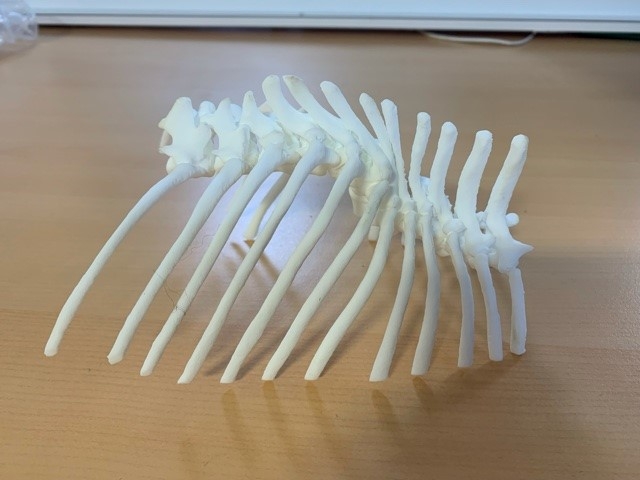
The 3D model of Frank's spine copyright IVC Evidensia
3D Printer Helps Dog Walk Again
A 3D-printed model of a dog’s spine has helped him walk normally again.
French Bulldog Frank’s hindlimb mobility was badly impacted due to a malformation of his spine.
But the 3D-printed model let vets at Pride Veterinary Centre plan complex spinal surgery in advance, assessing screw sizes and precise placement before the procedure.
There was a marked improvement in the dog’s walking within days and urinary incontinence problems also cleared quickly.
Now Emma Suiter, neurology resident at the IVC Evidensia specialist referral centre, is hoping to use the high-tech 3D modelling technique to treat other challenging cases.
The dog was referred to the neurology department after his Nottingham owner became concerned by his walking difficulties and repeated urinary incontinence.
“This had come on suddenly over a three-week period and he was essentially walking as if he was drunk in his back legs,” said Emma.
“He was a lovely, friendly little dog but the examination confirmed he was ambulatory paraparetic and ataxic. Although the condition wasn’t painful, he was uncoordinated in his hindlimbs and was also dribbling urine during the consultation. These were signs that would eventually cause far more problems in the future.
“His findings indicated a spinal issue and the MRI showed vertebral malformations of the T6-T8 vertebrae. This resulted in marked scoliosis and kyphosis, vertebral canal stenosis and compression of his spinal cord.
“Although we don’t see many of these cases, a recent research paper indicated there was a very good prognosis if you can successfully straighten the spine.”
It was decided to have a 3D-printed model of Frank’s spine made to aid the procedure.
And the pinpoint accuracy of the model proved highly advantageous.
“It wasn’t just a case of studying it before, but actually taking it into surgery with us,” said Emma.
“While we were looking at his bones in front of us, we could also have a feel of the model and ensure we were placing the screws where we wanted them.
“It gives you that extra bit of reassurance and security.”
A total of seven screws were used, two in the vertebral bodies of T9, T8 and T6 and one within the vertebral bodies of T7.
A small volume of PMMA (bone cement) was moulded around the protruding screwheads to provide the desired fixation. A post-operative CT scan showed the vertebral column was less kyphotic, with a widening of the vertebral canal by approximately 1.9mm.
A follow-up examination 10 days after discharge showed a marked improvement that has been maintained through subsequent post-operative checks.
“He was walking better within a day of the surgery and the urinary incontinence cleared up remarkably quickly,” said Emma. “It was a very satisfying case.
“My supervisors Annette Wessmann and Rosario Vallefuoco, European Specialists in Neurology and Small Animal Surgery respectively, who were also in the surgery, have used 3D-printed modelling before, but it was the first time for me.
“I definitely want to do more of this, and I think it can have major benefits.”
If you are attending BSAVA in March, IVC Evidenisa will be on stand D401.
More from IVC Evidensia UK & IE

 2 years ago
2 years ago  788 views
788 views